
TABLE OF CONTENT :-
1.1- Human Eye
1.2- Visual Defects and their Correction
1.3- Refraction of Light through a Prism
1.4- Dispersion of White Light by a Glass Prism
1.5- Atmospheric Refraction
1.6- Scattering of Light
INTRODUCTION
The human eye uses light and enables us to see objects around us.
There is a lens in the structure of the eye.
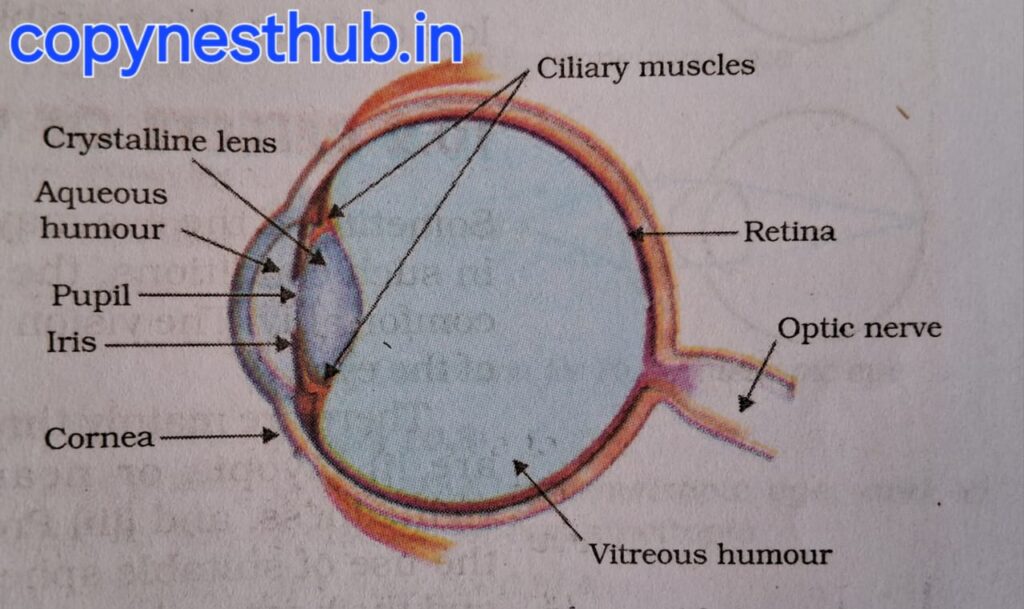
||1.1 || TOPIC NO.1- HUMAN EYE
The human eye is a very valuable and sensitive sense organ.
By closing our eyes we can recognize objects to some extent by their smell, taste, sound produced by them or by touch. It is possible to recognize colors by closing our eyes.
The human eye is like a room, its lens forms an image on a light-sensitive screen called retina .
Light enters the eye through a thin membrane,this membrane is called the cornea or clear membrane .
This membrane forms a transparent bulge on the front surface of the eyeball. The shape of the eyeball is almost spherical and its diameter is about 2.3 centimeters.
Most of the refraction of light rays entering the eye occurs at the outer surface of the cornea.
Behind the cornea is a structure called the iris . The iris is a deep muscular diaphragm that controls the size of the pupil.
The pupil controls the amount of light entering the eye.
The eye lens forms an inverted and real image of an object on the retina.
The retina is a delicate microscopic membrane containing a large number of light-sensitive cells. When illuminated, the light-sensitive cells become active and generate electrical signals. These signals are transmitted to the brain via the optic nerve. The brain interprets these signals and ultimately processes this information so that we see an object as it is.
Aqueous humour:- A fluid present inside the eye is called aqueous humour. It is present in the space between the cornea and the lens. Aqueous humour is also known as aqueous humour. It maintains a special pressure inside the eye. It helps in maintaining the spherical shape of the eye. It provides nutrition to the internal organs of the eye like lens and cornea. It also helps in removing waste matter from these organs.
Optic nerve:- The nerve connected to the eyes is called optic nerve. This nerve transmits the visual signals coming from the eyes to the brain. It works like a cable which transmits the visual signals coming from the eyes to the brain.
Ciliary muscles:- The ciliary muscles of the eye are called ciliary muscles. These are internal muscles of the eye. These muscles change the focal length of the lens, due to which an image of an object is formed on the retina. These muscles control the accommodative ability of the eye. These muscles adjust to see objects at different distances.
Vitreous humor:- Vitreous humor is a jelly like fluid filled inside the eyes. It is filled inside the eyeball and helps in maintaining the shape of the eyes. Vitreous humor also allows the light to pass through to reach the retina. It is a transparent gel. It is made up of 99% water.
It fills the space between the lens and the retina. It helps in keeping the eyes inflated. It helps the eye to maintain its shape.
Damage to any part of the visual system can cause significant loss of visual function.
Accommodating power: The ability of the eye lens to adjust its focal length is called accommodating power.
The eye lens is made of fibrous jelly-like substance. Its curvature can be changed to some limits by the ciliary muscles. When the curvature of the lens changes, its focal length also changes.
When the muscles relax, the eye lens becomes thinner. Thus its focal length increases. In this condition, we are able to see distant objects clearly.
When we look at objects near the eye, the ciliary muscles contract. This increases the curvature of the eye lens. The eye lens now becomes thicker, as a result the focal length of the eye lens decreases. This allows us to see nearby objects clearly.
The focal length of the eye lens is not less than a certain minimum limit. To see any object clearly and comfortably, we have to keep it at least 25 cm away from the eyes.
Near point:- The minimum distance at which an object can be seen very clearly without any strain is called the minimum distance of distinct vision. It is also called the near point of the eye. For a normal eye, it is about 25 cm.
Far point :- The farthest point up to which an eye can see objects clearly is called the far point of the eye. For a normal eye it is at infinite distance.
Sometimes the crystalline lens of the eye of some older people becomes milky and blurred, this condition is called cataract. Due to this, the vision of the eye decreases or you face problems in seeing completely. After cataract surgery, it is possible to regain vision.
Why do we have two eyes for vision? Why not just one? -There are many advantages of having two eyes instead of one. This expands our field of vision. The horizontal field of vision of one human eye is about 150 degrees, while with two eyes it becomes about 180 degrees.
Each eye sees a slightly different image of an object. Our brain combines the two images and creates one image.
|| 1.2 || TOPIC NO.2- VISION DEFECT AND THEIR CORRECTION
Sometimes the eyes may gradually lose their ability to accommodate. In such conditions, a person is unable to see objects clearly comfortably.
There are mainly three common refractive errors of vision:-
1- Myopia
2- Hypermetropia
3- Presbyopia
These directions can be corrected by using suitable spherical lenses.
A-Myopia- Its other name is also called nearsightedness. In this, a person can see the nearby objects clearly but he cannot see the far away object clearly.
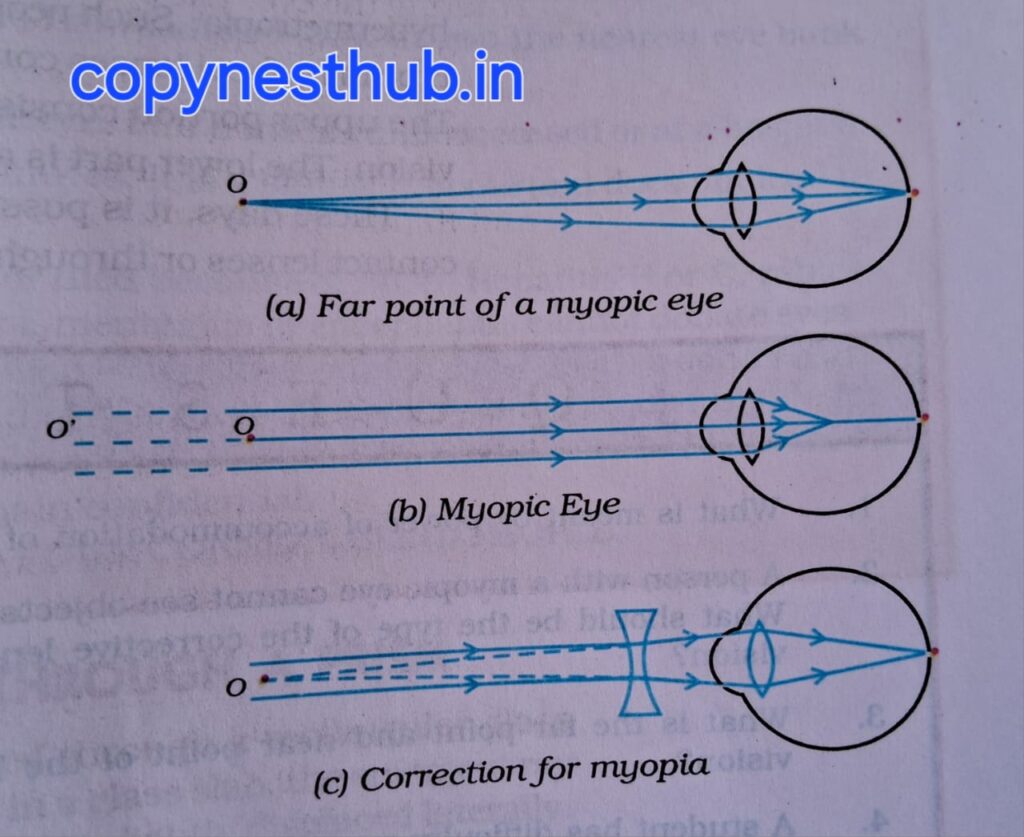
The far point of such a person comes closer to the eye instead of being at infinity. Such a person can clearly see objects placed a few meters away.
In an eye with nearsightedness, the image of a distant object is not formed on the retina but in front of the retina.
The reasons for the occurrence of this defect are:-
1- Excessive curvature of the eye lens.
2- The eyeball becomes longer.
This defect can be corrected by using a concave lens (diverging lens).
B- Long sightedness- Its other name is also called far sightedness. In this a person can see distant objects clearly but cannot see nearby objects clearly.
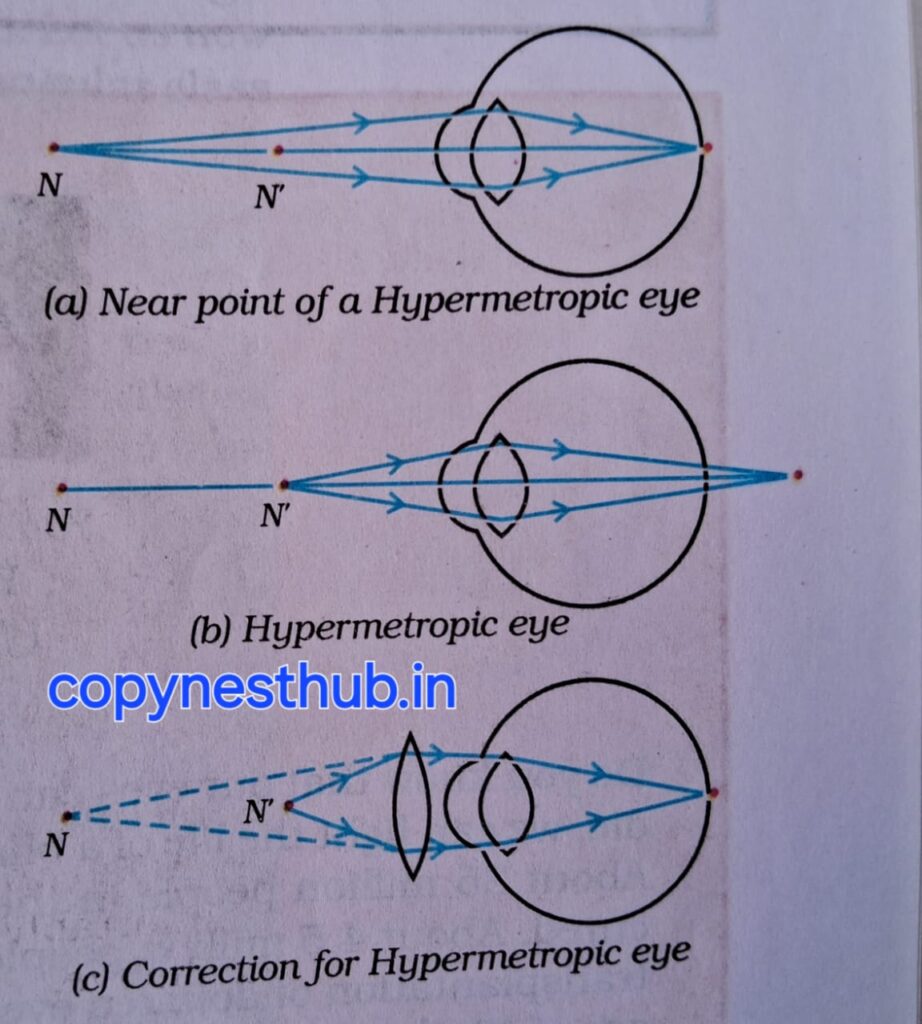
The near point of such a person shifts away from the normal near point. Such a person has to keep the reading material at a distance much greater than 25 cm from the eye to read comfortably and clearly.
In an eye with long-sightedness, the image of an object placed nearby is not formed on the retina but behind the retina.
The reasons for the occurrence of this defect are:-
1- The focal length of the eye lens becomes too long.
2- The eyeball becomes smaller.
This defect can be corrected by using a converging lens (convex lens) of suitable power.
C-Presbyopia- Some people develop both nearsightedness and farsightedness simultaneously during old age. This is called presbyopia.
Such a person needs a bifocal lens. The upper part of it is a concave lens. It helps in seeing distant objects clearly. The lower part is a convex lens. It helps in seeing nearby objects clearly.
|| 1.3 || TOPIC NO.3-REFRACTION OF LIGHT THROUGH PRISM
A prism is a transparent medium surrounded by three rectangular and two triangular layers.
The rectangular surface refracts light.
An angle is formed between the two sides, which is called the prism angle. An ideal prism has an angle of 60 degrees. [less than 90 degrees]
How does light refract when passing through a triangular glass prism – Here PE is the incident ray, EF is the refracted ray and FS is the emergent ray. On the first surface AB, the ray of light is entering the glass from air. After refraction, the ray of light turns towards the normal. On the second surface AC, the ray of light is entering the air from the glass, hence it goes away from the normal.
Deviation angle: Due to the special shape of the prism, the emergent ray makes an angle with the direction of the incident ray, this is called the deviation angle.
Refractive index of a prism = The formula for refraction of a prism is: μ = sin(A + δm)/2 / sin(A/2), where μ is the refractive index of the material of the prism, A is the angle of the prism, and δm is the angle of minimum deviation.
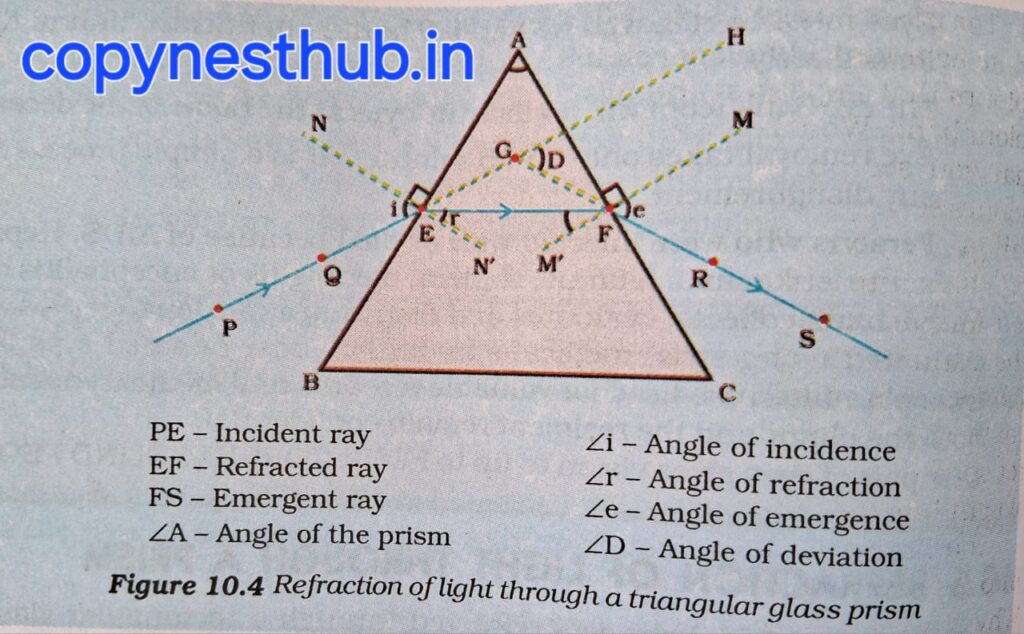
|| 1.4 || TOPIC NO.4- DISPERSION OF WHITE LIGHT BY A GLASS PRISM ||
Prisms split the incident white light (sunlight) into bands of different colours.
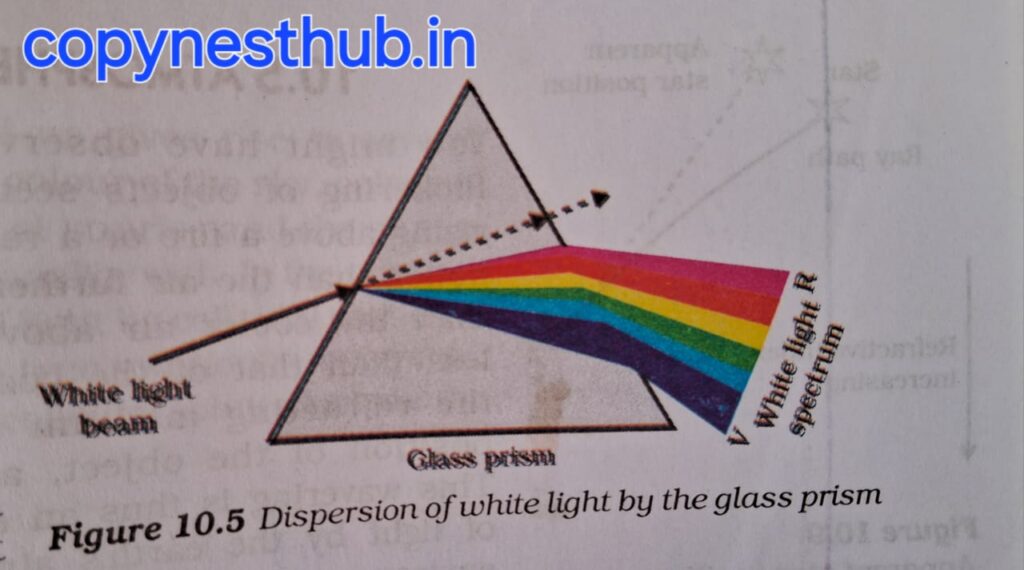
1-Violet
2-Indigo
3-Blue
4-Green
5-Yellow
6-Orange
7-Red
This sequence can be remembered using VIBGYOR .
Spectrum- The band of constituent colours of light is called spectrum.
Dispersion- The splitting of light into its constituent colours is called dispersion.
White light is dispersed by the prism into its constituent colours.
After passing through a prism, different colours of light bend at different angles relative to the incident ray.
Red light bends the least while violet light bends the most.
Newton first used a glass prism to obtain the spectrum of the sun. Using a second identical prism he tried to further divide the colours of the white light spectrum but could not obtain further details.
Sunlight is made up of seven colours.
Rainbow- It is a natural spectrum seen in tiny particles of water in the sky after rain. Rainbow always forms in the opposite direction of the sun. Tiny droplets of water act like prisms.
|| 1.5 TOPIC NO.5 || – ATMOSPHERIC REFRACTION
The hot air is lighter and less dense than the cooler air above it, and its refractive index is slightly lower than that of the cooler air.
The physical conditions of the refracting medium (air) are not stable, so the apparent position of the object keeps changing when seen through hot air. Thus this instability is the effect of atmospheric refraction (refraction of light due to the earth’s atmosphere) on a small scale in our local environment. Twinkling of stars is such a phenomenon on a large scale.
Twinkling of stars:- Stars appear to twinkle due to atmospheric refraction of starlight.
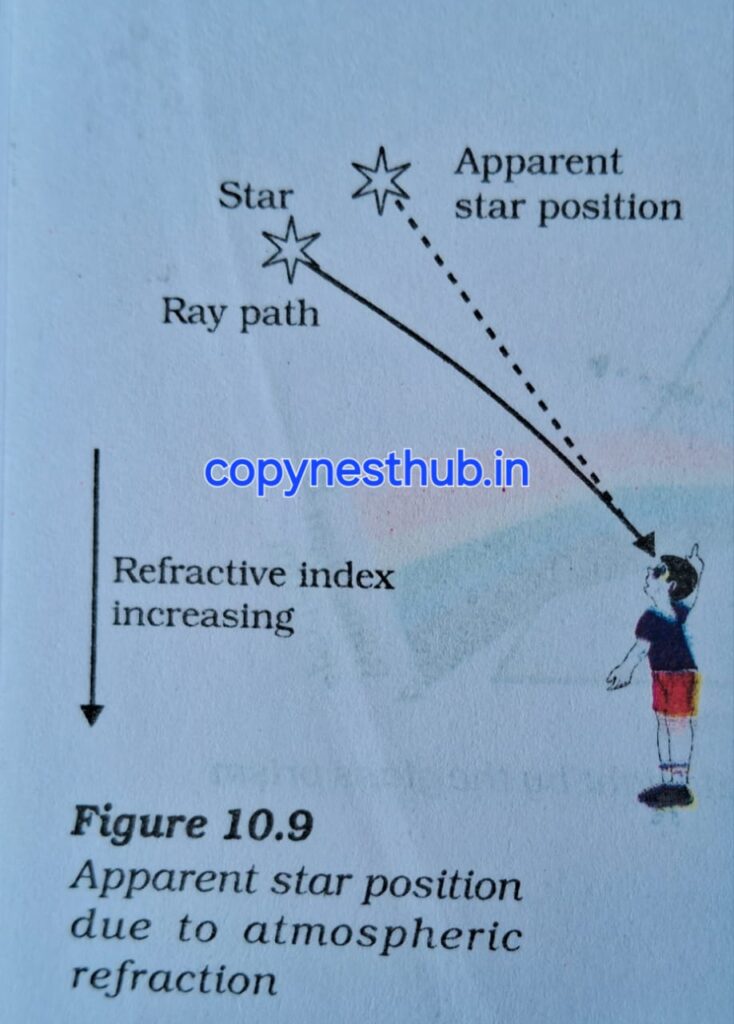
After entering the Earth’s atmosphere, the star’s light continues to refract until it reaches the Earth’s surface.
The atmosphere bends the star’s light towards the normal, so the apparent position of the star appears to be slightly different from its actual position.
This virtual position of the star is not permanent, it keeps on changing gradually, because the physical conditions of the earth’s atmosphere are not permanent. Hence, the path of light rays coming from the stars keeps on changing slightly, hence the virtual position of the star keeps on getting deviated and the amount of light of the stars entering the eyes keeps on flickering.
Why do planets not twinkle?
Planets are much closer to the Earth than stars. Because of this, the average value of the total change in the amount of light entering our eyes will be zero, due to which the twinkling effect will disappear.
What is early sunrise and late sunset?
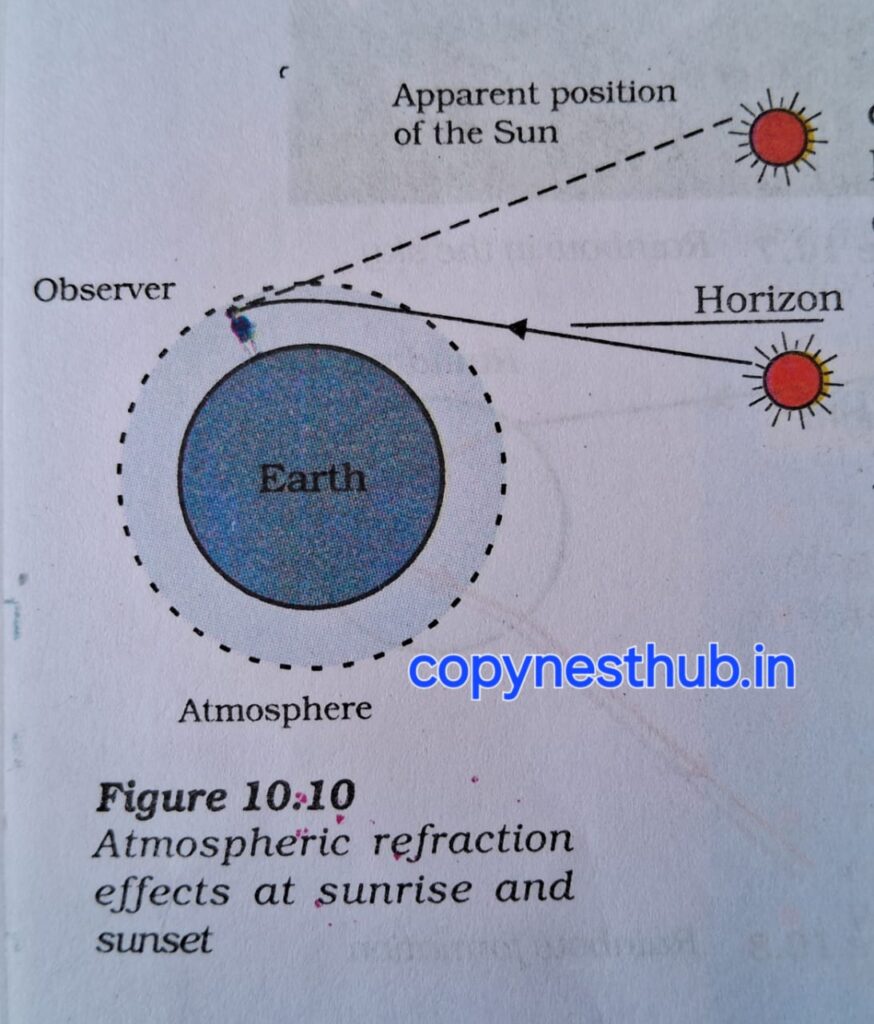
Due to atmospheric refraction, the Sun becomes visible to us about 2 minutes before the actual sunrise and remains visible till about 2 minutes after the actual sunset.
By actual sunrise we mean the sun actually crossing the horizon.
TOPIC NO.6- Scattering of light
What is the Tyndall effect?
This atmosphere of the earth is a heterogeneous mixture of microscopic particles. These particles include smoke, water droplets, dust particles and air particles. When a light ray hits such a fine particle, the path of that ray becomes visible. When sunlight passes through a dense forest, the Tyndall effect can be seen in it.
Why is the colour of the clear sky blue?
The wavelength of red light is about 1.8 times that of blue light. So when sunlight passes through the atmosphere, the small particles of air scatter the blue colour (shorter wavelength) more strongly than the red colour. The scattered blue light enters our eyes and we see the sky as blue. If there was no atmosphere on the earth, there would be no scattering, then the sky would appear black. The sky appears black to passengers flying at high altitudes because the scattering is not clear at such a height.
Colour of the sun at sunrise and sunset?
Horizon-The horizon is the line or circle that marks the boundary between the earth and the sky. It is a point where we see the earth and the sky meet.
The word “Raktaabh” means “reddish” or “reddish”. This word is derived from Sanskrit where “rakt” means red and “aabh” means aura or shine. The light coming from the Sun near the horizon passes through thick layers of air in the Earth’s atmosphere before reaching our eyes. When the Sun is directly above the head, the light coming from the Sun travels a relatively shorter distance. The Sun appears white at noon because only a small portion of the blue and violet light is scattered. Near the horizon, most of the blue and low wavelength light is scattered by the particles, so the light reaching our eyes is of higher wavelength. This makes the Sun appear reddish at sunrise or sunset.
Due to scattering of light :- The colour of the sky is blue and the sun appears reddish at sunrise and sunset.
Due to atmospheric refraction :- Twinkling of stars, early sunrise and delayed sunset occurs.